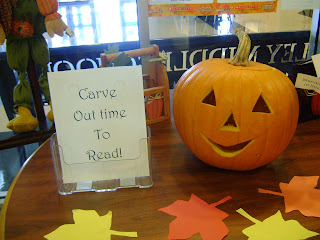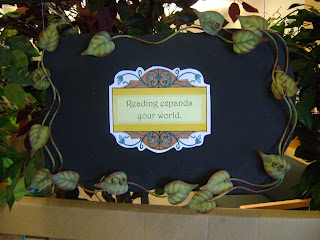The library window display for last month was fantasy, which one definition described it as unrestrained fancy. The Texan in me changed it to 'unbridled' fancy. I tried to unbridle my own mind and not think too hard about what I would include in the display other than using what materials I had on hand and trying to make it magical-looking or whatever strikes my fancy. It looks busy and cluttered-- not to be taken in and understood with a quick glance. There are layers and enigmas and oddities about it, much like fantasy stories.

So I used styrofoam packing materials, a lot of large rubber bands I've collected from our newspapers, window frames, vines created from twisted strips of bulletin board paper, a yellow brick road on the rubber mats from AV carts, and a lot of fantasy books to display including Frank L. Baum's Oz books (and there are more than just The Wizard of Oz), Kathryn Lasky's Guardian of Ga'hoole books, Tony Abbott's Secrets of Droon books, Erin Hunter's the Warriors books and other authors' books such as Tolkien, Potter, Barron, Lewis, and a number of others.
A book that is considered a fantasy has magical elements in it-- something that couldn't necessarily happen in real life-- talking animals, flying brooms, mythical creatures like dragons or ogres, inanimate objects coming to life, etc. Fantasy stories can take place in the distant past or future, or even a contemporary or present setting.
Often fantasy and science fiction are grouped together, but there are differences between them. Sci-fi usually takes place in the future and could potentially happen when technology catches up with the story. Often sci-fi writers are in the science or medical fields and can draw on their knowledge and backgrounds to come up with believable plots. With sci-fi and fantasy both, if the story has extraordinary technology and magical elements, it still has to ring true somehow or the reader won't commit to it.
"Scales" by Vanessa Roeder, Used with permission
Some of the most prolific readers in my middle school are fantasy readers. The library has a large collection of fantasy books, and many of them are in series, which students love because the stories and the characters they've become attached to don't end after one book.

































